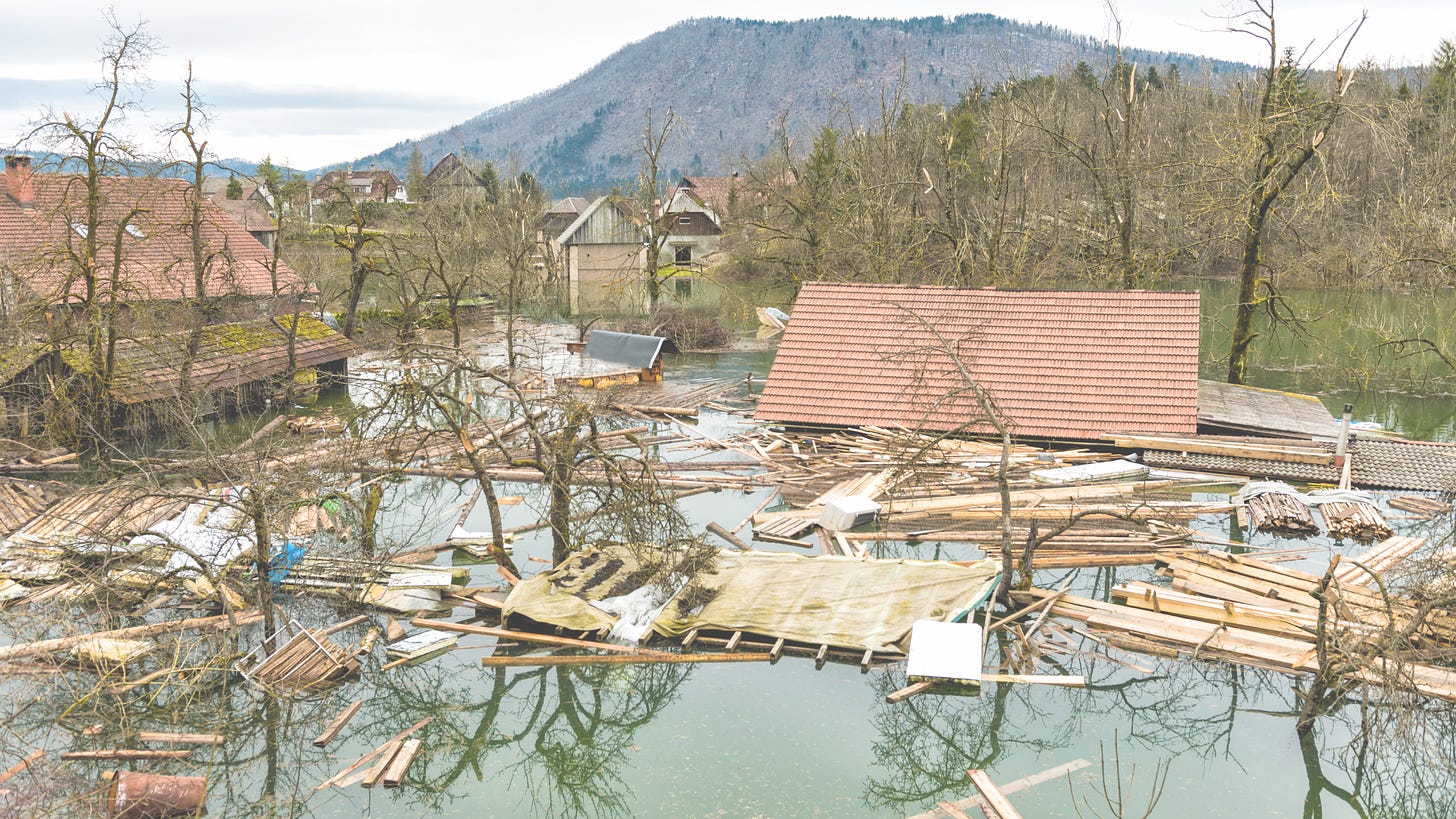The top five climate risk stories this week
1) Banks falling short of Paris climate goals

Banks have to speed up their decarbonization efforts if they are to align with climate pathways set out by the 2015 Paris Agreement, an analysis conducted by two investor groups shows.
The Institutional Investors Group on Climate Change (IIGCC) and the Transition Pathway Initiative (TPI) published a set of net-zero indicators for the banking industry on Thursday. These were used to grade 27 global banks across six areas: net-zero commitment; short- and medium-term targets; decarbonization strategy; climate policy engagement; climate governance; and audit and accounts.
In the area of decarbonization strategy, the analysis showed very few banks disclose “comprehensive policies that restrict financial flows to high emission sectors and activities.” Banks’ climate engagements with carbon-intensive clients were also found wanting. Out of all the banks assessed, French lender Crédit Agricole scored highest on decarbonization strategy, as it was aligned with the most sub-indicators for that area. Three Chinese lenders — Agricultural Bank of China, Bank of China, and Industrial and Commercial Bank of China — scored lowest, as they did not align with a single sub-indicator for the category.
The IIGCC and TPI concluded that banks’ “overall weak performance” on decarbonization strategy represents “a challenge for investors” that want to understand how credible their climate targets are.
“Banks have increasingly committed to net zero targets for their financed emissions,” said Professor Simon Dietz, who led the TPI research team. “However, [they] have yet to show how they plan to meet these net zero targets. For example, banks’ targets often omit large portions of their portfolios (such as underwriting and advisory) and exclude certain high-emitting sectors. Banks’ policies often still allow for continued finance to carbon-intensive activities such as coal mining and deforestation, and evidence of engaging with high emission companies on transition plans is sparse.”
Overall, banks scored lowest in the area of climate policy, with just one firm — Canadian lender Bank of Montreal — aligned with any of the relevant sub-indicators. Climate governance was the area banks performed best in, with each firm on average aligned with 44% of the relevant sub-indicators. US lender Citi scored highest in this area.
The IIGCC and TPI plan to unveil a comprehensive net-zero assessment framework for the banking industry later this year, which institutional investors can use to compare and contrast different lenders’ climate performance.
2) US Treasury launches tool to identify climate threats to financial stability

A new ‘Climate Analytics and Data Hub’ developed by the US Treasury’s research unit aims to help federal agencies police climate risks to the financial system.
Announced Thursday, the Hub allows regulators to integrate climate-related information from across the federal government — including data on wildfires, crop condition, and rainfall patterns — with their own supervisory datasets. This way, they can get a clearer understanding of how changing climatic conditions could impact financial stability. The Hub also offers statistical and visualization tools to better illustrate climate-related financial risks.
“Delivering a clearer assessment of financial risks due to climate change requires both climate data and financial data — information that is often siloed — and the ability to integrate these data,” said Nellie Liang, the Treasury Department’s Under Secretary for Domestic Finance. The Hub will “help streamline regulators’ access to this critical information,” she added, thereby proving a “more comprehensive view of climate-related financial risks.”
For now, the Hub pilot is being tested by the Federal Reserve Board and Federal Reserve Bank of New York. Ultimately, the tool will be made accessible to all the agencies represented on the Financial Stability Oversight Council, the US’s top regulatory panel.
3) Climate shocks call for macroprudential response — ECB

Policies that increase the resilience of the euro area’s financial system are needed to cope with climate shocks, a report from the European Central Bank (ECB) says.
Lawmakers could use existing macroprudential tools — with some adjustments — to head off climate-related systemic risk, it explains. For example, the systemic risk buffer could be used to increase the amount of capital European banks have to hold against loans to climate risk-sensitive sectors. Or concentration limits could be introduced to curb excess lending to clients in regions threatened by destructive physical risks, and to companies likely to struggle through the low-carbon transition.
“Crossholdings and common exposures across the financial system will likely amplify the materialisation of climate risks, warranting the inclusion of a system-wide perspective for the policy response,” the report says. It adds that climate change threats “go beyond the idiosyncratic risks of individual institutions and investors” and are not covered by institution-specific regulations.
The ECB paper also elaborates on how climate shocks could whip through the financial system and European economy, harming banks and companies alike. For instance, a spike in carbon prices could lead to a cascade of business failures, particularly among carbon-intensive firms. Combinations of extreme weather events and longer-running climate physical risks could similarly have a domino effect on asset valuations, leading to “an abrupt reassessment of climate risk pricing” and the potential fire-sale of affected securities.
4) Standards for voluntary carbon markets launched

Carbon credit standard-setter the Integrity Council debuted a proposal on Wednesday to create a “definitive and consistent global benchmark” for offsets and carbon removals sold in voluntary markets.
The Core Carbon Principles (CCP), developed by a panel of experts from business, academia, and civil society, are intended to establish baseline standards for carbon credits, carbon-crediting programs, and methodology types. The Integrity Council hopes the principles will increase accountability and confidence in carbon credit schemes, which in turn should deepen voluntary carbon markets and spur greater investment in carbon offset, sequestration, and removal projects.
An accompanying assessment framework developed by the council will enable market stakeholders to judge which carbon credit schemes are “based on solid science and best practice” by how well aligned they are with the CCPs.
“High-integrity reductions and removals are both critical. Emissions reductions will be around 90% of climate action required by 2050. And we know from the IPCC [Intergovernmental Panel on Climate Change] that emissions removals will also be essential to hit 1.5°C. That means we need every tool available to us working at full speed,” said Annette Nazareth, Chair of the Integrity Council.
A public consultation on the principles is open until September 27.
5) Extreme weather, natural catastrophes cost $65bn in H1

Natural disasters inflicted $65 billion of losses over the first six months of this year, according to global reinsurer Munich Re. Many of these costly catastrophes were linked to extreme weather events, which climate change is making more frequent and intense.
“They may all be individual events with different causes, but taken together, one thing is becoming extremely clear: the powerful influence of climate change is becoming ever more evident! And the consequences for people across the world are becoming ever more palpable,” said Ernst Rauch, Chief Climate Scientist at Munich Re.
The reinsurer determined that Australia’s extreme floods in February and March were the most costly disaster over the first half of the year, with insured losses coming in at $3.7 billion. Climate scientists say global warming is making extreme floods in northern Australia more likely.
Overall, the US incurred the highest dollar toll from natural disasters — $28 billion. Of these losses, nearly two-thirds were insured.

